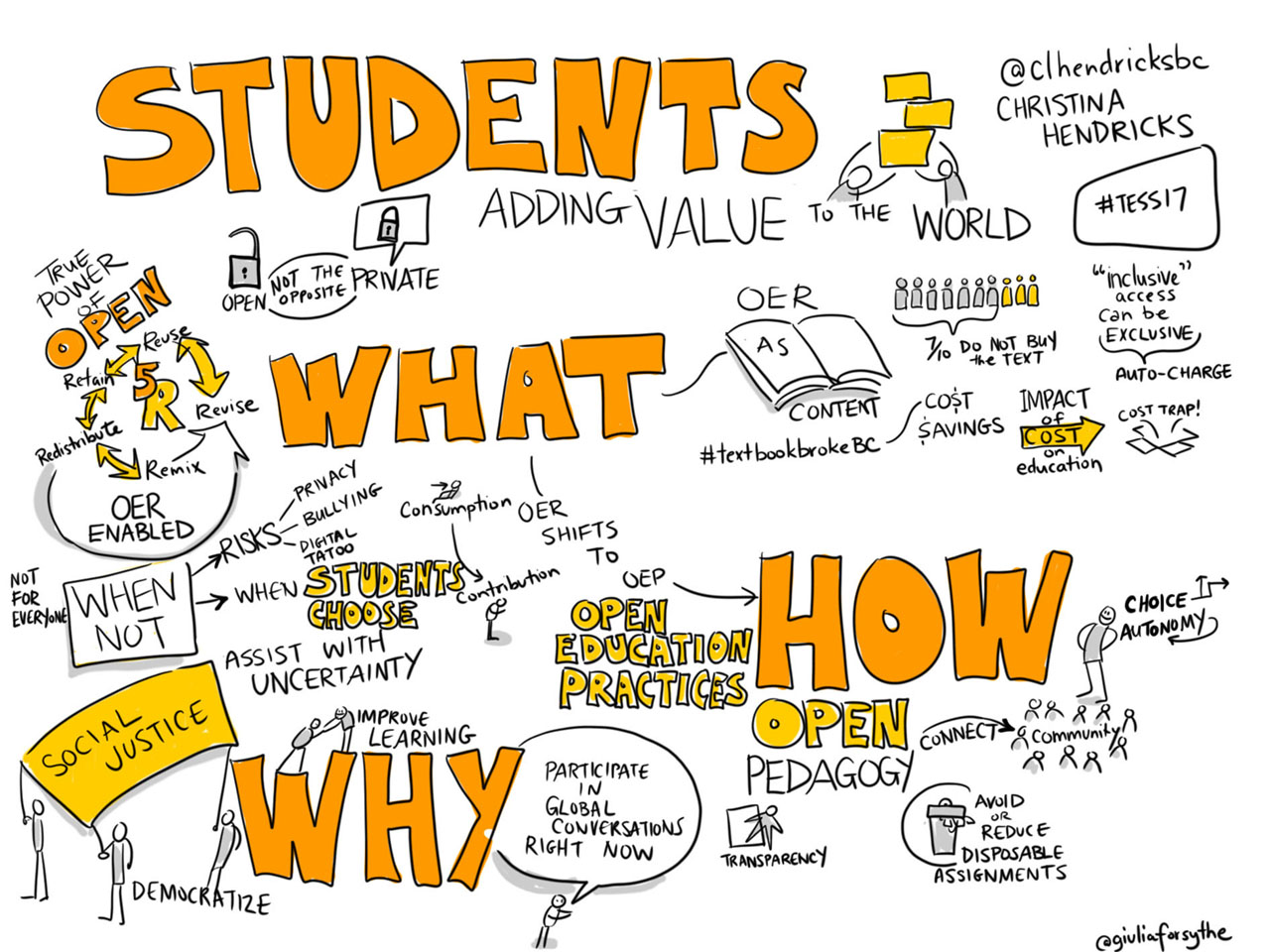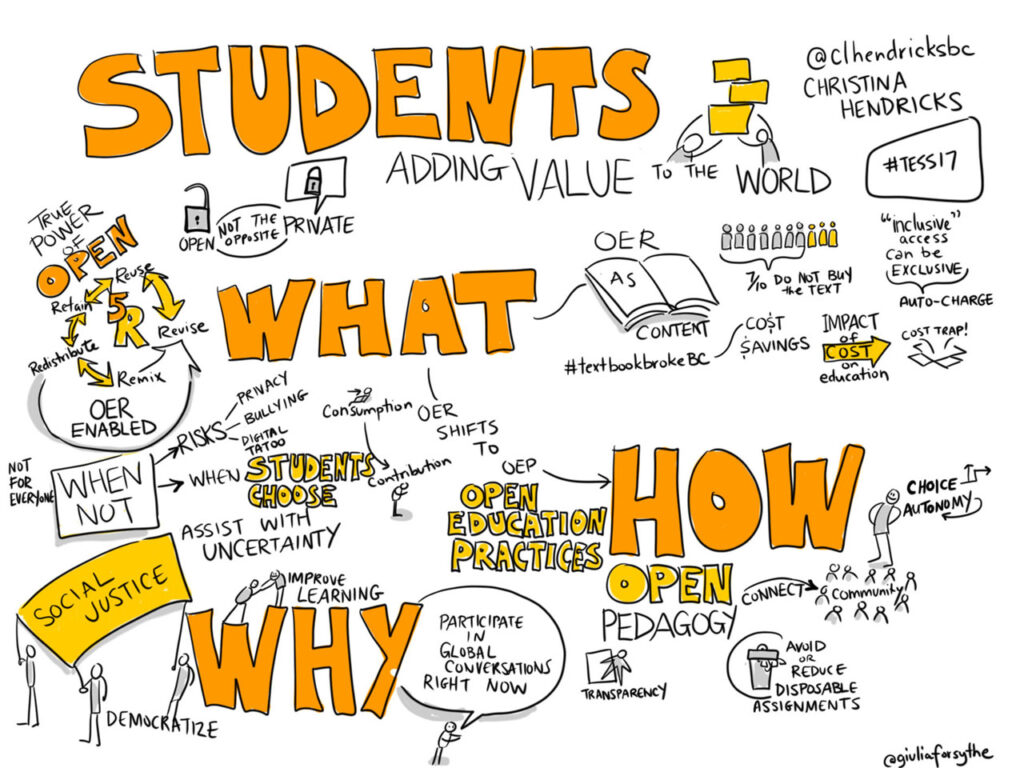
Invite students to publish
Are you interested in encouraging your students to create work to share with others? Adding your voice to the domain knowledge–which shapes our education–is a strong motivator. As teachers, writers, designers, and artists we long to create and share.
What is Open Pedagogy?
If you are familiar with the information fluency and Learning Assessment Cycle information as presented on CTL you see that to complete the cycle there is a contributing element. That’s where open pedagogy or open educational practices come in. I use them interchangeably like Hendricks in her post on navigating open pedagogy [1]. My focus is not on the wordplay or the definition but on the creation and student participation. I prefer to think of it as giving back or giving forward. Students can make, remake, or present materials in a way inexperienced students or novices to the topic can understand. Benefits include helping your students to learn from one another.
Another approach is to consider open pedagogy as a natural extension of Open Education Resources (OER) [2]. Participate on your own or with your students. Ehlers defines open educational practices “as practices which support the (re)use and production of OER through institutional policies, promote innovative pedagogical models, and respect and empower learners as co-producers on their lifelong learning path” [2].
Do your students want it?
Experiential learning and service-learning could easily lead you to this path. I argue students do want it, but are resistant to the means we generally use. Many students don’t like group projects. They do like making items for use in their portfolio to demonstrate their abilities. Start small, and get their buy-in.
What are others doing?
One example referenced in The Values of Open Pedagogy is a final project that the students wrote to submit materials for publication in a peer-reviewed Hybrid Pedagogy journal that may appeal to you [3]. Openpedagogy.org contains examples that include successes like Dr. Crowther’s. She exposed her students to online resources lacking information–on women in STEM–then helped them understand and practice how to submit work to fill in the gap [4].
Two ways you can have your students create materials and contribute to domain knowledge are included in a list of ideas in the Learning Assessment Cycle article on CTL: “1. Presenting a refined version of the activity to a cohort of peers to share their new mastery of a domain area by posting a video abstract of a project on YouTube that is shared with the class. 2. Ultimately contributing something new to domain knowledge by submitting any truly original research, ideas, or projects to online journals, websites, or online communities where their contributions would be valued“ [5].
Our graduate students create theses and projects which are entered into the library system. That is a daunting series of tasks. By doing so, they complete the learning cycle. You can have your undergraduate students learn about, work on, share with their peers, and provide a newly created item to the domain knowledge. Do it in an open and public way or in a protected environment within your course, or on a private platform used by your program.

How do I start?
- Evaluate your course.
- is there space for student creation?
- Explain the arc of the process to your students.
- We will have an activity and assessment where you will present to your peers, and ultimately upload to an open arena for others to view and potentially use
- Cover creative commons (CC) and licensing
- Test your materials on your peers or on your students with their agreement.
- Determine where and how to have your students share.
- places your students may share their CC work include YouTube, Wikipedia, Deviant Art, Wikimedia Commons, codepen.io, and Flickr.
Have students create where you do, or where you are comfortable. For me, that would be codepen.io. They can explore topics, suggest a topic or provide an open section of code to share with others.
Investigate Open Educational Practices (OEP) as a way to “respect and empower learners as co-producers on their lifelong learning path”.[1] I am invested in Open Pedagogy “as a process of designing architectures and using tools for learning that enable students to shape the public knowledge commons of which they are a part “ [2]. There is far more to this conversation, but that is material for a future tip or come into an Open Lab session for a conversation.
Go explore Open Pedagogy and this presentation “What’s open about open pedagogy?”
P.S. I know there are many, some conflicting, definitions of open pedagogy. If you’re new to this discussion please take a look at this post on “What is Open Pedagogy?” addressing some of the history and thinking. Janene McMahan
References
[1] Villeneuve, C. (2018, May 17). Navigating open pedagogy, part 2.
[2] Ehlers, U.-D. (2011). “Extending the Territory: From Open Educational Resources to Open Educational Practices”. Journal of Open, Flexible and Distance Learning. 15 (2).
[3] McAndrew, A., Sinkinson, C., Keyek-Franssen, D. (2018). The Values of Open Pedagogy. EDUCAUSE review: Why IT Matters to Higher Education.
[4] Villeneuve, C. V. (2018, May 17). Editing Wikipedia in the Classroom: Individualized Open Pedagogy at Scale
[5] Lott, C. (n.d.). Pedagogy Resources.
The feature image is part of the public domain–by the author’s choice.

Janene McMahan
Former Member of the UAF Instructional Design Team
Quality Matters Coordinator
Google Certified Educator

